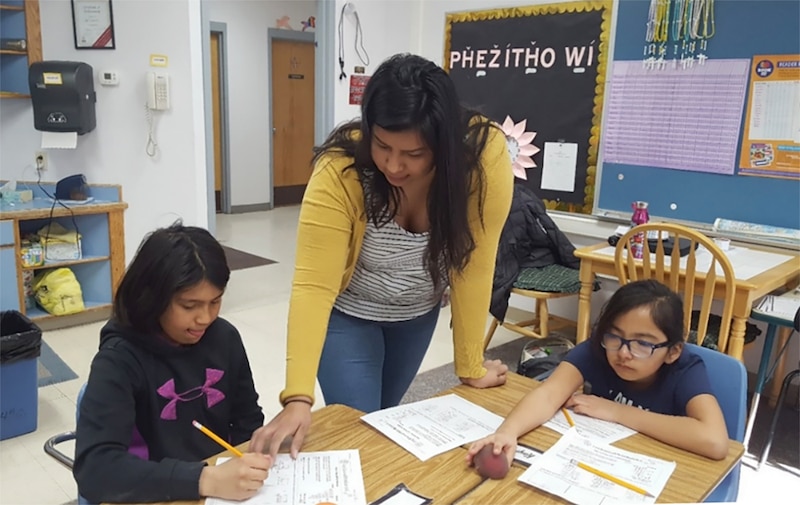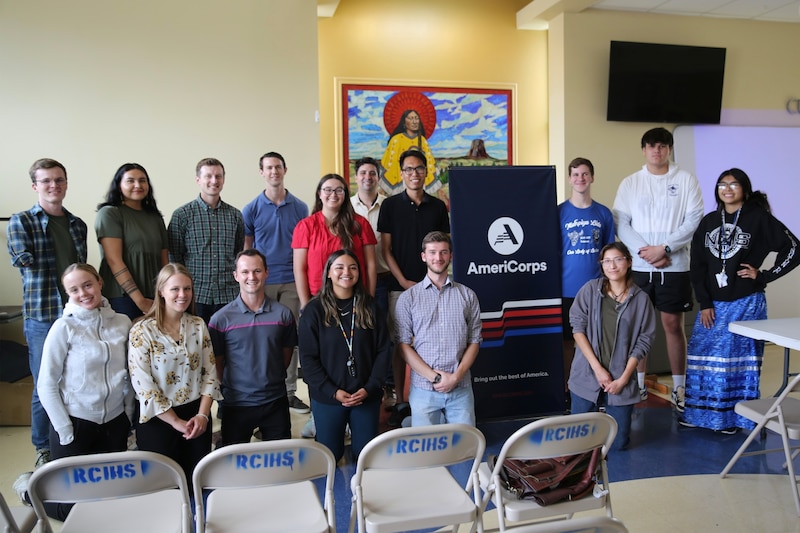Sign up for Chalkbeat’s free weekly newsletter to keep up with how education is changing across the U.S.
When a federal judge earlier this month ordered the Trump administration to restore AmeriCorps funding, there was no relief for the hundreds of service groups that tutor children and staff summer programs in Republican-led states that sat out the lawsuit.
Even in the 24 Democrat-led states that challenged the cuts and won a temporary victory, the logistics of reinstating funding remain unclear. Some states are hesitant to turn on the tap when a higher court could still uphold the cuts. And with approximately 85% of AmeriCorps staff on paid leave, the department has limited ability to actually restore the grants and provide guidance to states. The uncertainty is complicating school partnerships and recruitment efforts for the next school year.
State commissions that oversee AmeriCorps now are navigating “a really uneven field,” said Kaira Esgate, CEO of America’s Service Commissions, a national organization overseeing state service commissions, governor-led public agencies that distribute AmeriCorps grants.
Rural communities who tend to rely on the agency to fund both public service and job opportunities have been particularly hard hit.
AmeriCorps supports educational programs, conservation efforts, and community service across the United States. It funds national programs such as CityYear and Teach for America as well as smaller grassroots organizations. For many communities, AmeriCorps programming also provides a pipeline for recruiting future educators.
More than 28% of organizations receiving direct funding from AmeriCorps are in states that did not have their funding reinstated, according to a Chalkbeat analysis.
This partial restoration of AmeriCorps funding is one example of a broader pattern that’s emerged, as Democrat-led states challenge the Trump administration in court, while Republican-led states don’t. For example, federal courts have restored pandemic relief money and National Institutes of Health grants only to states that sued, leading to unequal access to services and funding across the United States.
This Wednesday, a U.S. District Court in Maryland will hear a lawsuit brought by AmeriCorps-funded nonprofits, educational advocacy groups, and the AmeriCorps Employees Union AFSCME Local 2027. The lawsuit seeks a nationwide injunction that would restore funding in every state and put AmeriCorps agency staff back on the job before the 2025-26 school year.
“Our summer school and after-school programs have a lot of AmeriCorps people who work there, and suddenly all those people are no longer serving,” says Chris Giorlando, the grant manager at Mahpiya Luta , an AmeriCorps-funded K-12 school whose funding was not reinstated. “It limits what we can do for students.”
Rural communities hit hardest by AmeriCorps cuts
Mahpiya Luta serves the Pine Ridge Reservation in South Dakota, a state that did not join the first lawsuit. The school is one of the plaintiffs in the AmeriCorps lawsuit to be heard on Wednesday.
AmeriCorps staff at Mahpiya Luta provided one-on-one instruction for students, worked as classroom aides, supported after-school programming, and coached the school’s state-recognized sports teams.

“The AmeriCorps members who served here, the young Lakota people who served our program, really changed a lot of lives,” said Giorlando, an AmeriCorps alum. Giorlando received an email on April 25 notifying him that the school’s AmeriCorps grant would be terminated immediately by the federal government.
Following the termination of its grant, Mahpiya Luta was able to pay AmeriCorps members for the last three weeks of the school year by drawing from the school’s reserve budget. Originally, the AmeriCorps members would have been paid through the end of June, and AmeriCorps funding would have supported summer programming at the school.
Rural communities like Pine Ridge Reservation face especially high rates of teacher shortages and turnover. Many staff members at Mahpiya Luta came to the school through AmeriCorps programs.
“We used our AmeriCorps program as a kind of pipeline to get people interested in education and get into teaching,” said Moira Coomes, superintendent of Mahpiya Luta. “One of the really big problems in all rural areas is you just don’t have a bank of people waiting to become teachers.”
By offering job opportunities to people in the local community, AmeriCorps grants allowed Mahpiya Luta students to benefit from one-on-one mentorship from young adults on the Pine Ridge Reservation. Around 53% of children on the Pine Ridge Reservation live below the poverty line, according to 2023 data from the U.S. Census Bureau.

“It’s super important for kids, especially kids in a setting like ours, that they’re seeing adults who look like them, who come from where they come from,” Coomes said. “So that they see that as something they can aspire to.”
In the fall, Mahpiya Luta is hoping to find the money to hire at least kindergarten and first grade aides in the absence of grant funding, but without federal funding, the school’s ability to provide robust in-classroom support and after-school programming will be limited. Giorlando is still searching for alternative means of funding to help fill the void left by AmeriCorps cuts, but he noted that in rural communities, there are limited sources.
“Those are just holes that will not get filled,” Coomes said.
AmeriCorps funding uncertain despite federal judge’s order
Many of the states that should be receiving reinstated funds from AmeriCorps due to the federal judge’s order are still unsure when and how that will happen.
AmeriCorps notified nonprofits whose grants were reinstated the day after the June 5 injunction, but America’s Service Commissions is still waiting for further information from the agency in order to offer states guidance on next steps.
Following the grant terminations on April 25, a number of states placed “stop-service” orders in effect, immediately ending the work of AmeriCorps-supported programs by the following Monday, April 28. Many of these states have decided not to lift these restrictions as they wait for further clarity. The federal government has 60 days after the June 5 injunction to file an appeal, which could disrupt programs once again, although the federal government has yet to do so.
“We’ve got 52 commissions,” said Esgate of America’s Service Commissions. “I wouldn’t say that we have 52 different ways that people approach this, but quite a few different ways that we approach this.”
For example, AmeriCorps programs in Wisconsin have already restarted for the summer.
Easterseals Wisconsin, a summer camp for people with disabilities, is already in the process of onboarding new AmeriCorps members, a week after camp began. But Cally Ehle, the Easterseals grant manager, acknowledged that “there’s a possibility that they may shut us down again.”
“It’s a lot of scrambling now because there were a lot of things that needed to be done for enrollment and the handbooks and training. With everything being terminated, it just kind of shut down,” Ehle said.
By contrast, Michigan has kept its stop-service order in place, preventing AmeriCorps programs from returning to work, even despite the injunction. That’s hurt programs like the Michigan Education Corps, though some work can continue with other funding sources.
“The injunction got lifted, but that doesn’t mean that money is showing up,” said Holly Windram, the founder of Michigan Education Corps. “We lost about $130,000 of reimbursable dollars that we should have been able to get from AmeriCorps. With the injunction, in theory, we should be able to get that. Well, no one knows how that’s going to be facilitated.”
AmeriCorps grants for next school year are unsettled
As of now, AmeriCorps grants for the 2025-26 school year are still supposed to be allocated for all states. However, the majority of AmeriCorps staff has been placed on leave, severely limiting administrative ability. The case to be heard Wednesday seeks the reinstatement of this staff to ensure that grants for the next year can be properly allocated.
“We don’t know what that date is going to look like quite yet, but it is going to be later than normal, and I imagine that’s going to be incredibly disruptive,” Esgate said of when programs will get 2025-26 funding. “Typically education programs are always working to get members recruited, hired, trained, and that they’re ready to go the first day of school and that is definitely not going to happen this time around.”
The Michigan Education Corps has assured the schools in their network that they will continue providing programming, but they haven’t been able to follow up with individuals who have reached out to tutor with them for next year.
Given the delays in the group’s recruitment cycle, Windram worries that they might not have the volunteers they need to provide academic interventions for their students.
“It’s our kids that lose,” Windram said.
Correction: This article has been updated to correct the name of the nonprofit organization that oversees state service commissions. It is America’s Service Commissions, not the American Service Commission.
Norah Rami is a Dow Jones education reporting intern on Chalkbeat’s national desk. Reach Norah at nrami@chalkbeat.org.






